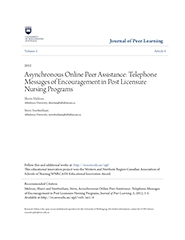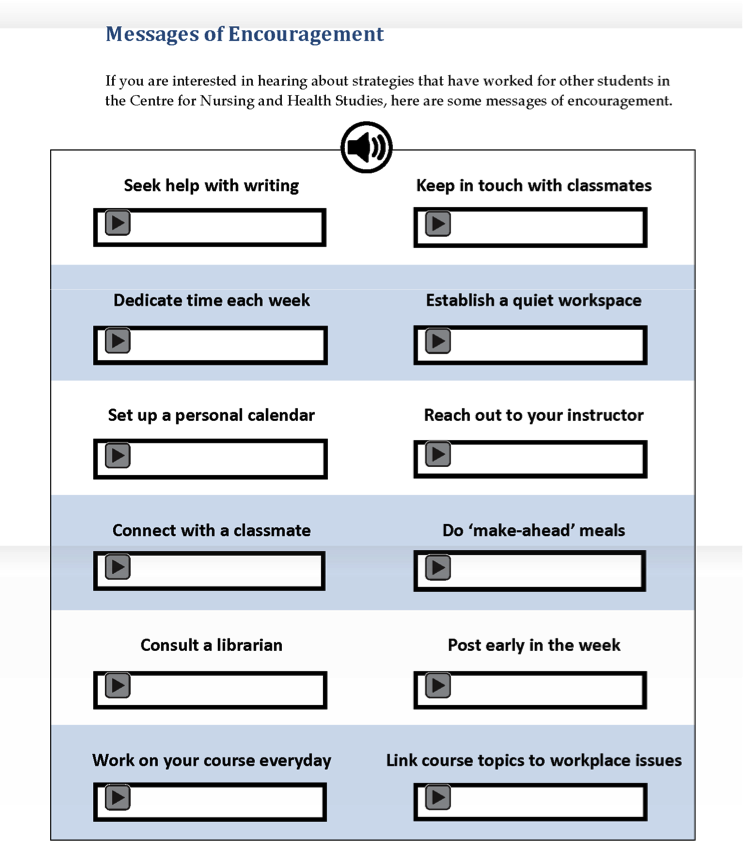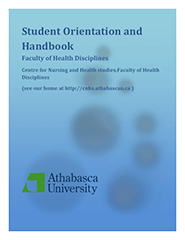20

Citation
Melrose, S. & Swettenham, S. (2012) Asynchronous online peer assistance: Telephone messages of encouragement in post licensure nursing programs. Journal of Peer Learning, 5(1), 1–5. Available at: http://ro.uow.edu.au/ajpl/vol5/iss1/4
Abstract
Peer assistance activities can strengthen online learning environments. And yet, like other professional adult learners, working post licensure nurses attending university part time to upgrade their credentials may have limited interest in student-to-student interaction. Some intentionally choose asynchronous self-paced courses so they can work on their own. This Telephone Messages of Encouragement educational innovation illustrates a peer assistance activity suitable for asynchronous courses in both undergraduate and graduate programs. Students’ recorded messages of encouragement to their peers are collected on a telephone answering machine as MP 3 files and then embedded in courses. The activity provides an option for students to ‘hear’ from other students at any time.
INTRODUCTION
Learning can be profoundly influenced by peer interaction (Vygotsky, 1978), peer collaboration (Slavin, 1985) and peer assistance (Topping & Ehly, 1998; Topping, 2005). In online learning environments, peer assistance can promote a sense of community (Huijser et al, 2008; Shackelford & Maxwell, 2012) and strengthen reflective practice (Ladyshewsky & Gardner, 2008).
Nursing education programs have a rich tradition of incorporating peer assistance activities (Gill et al, 2006; Secomb, 2008) and continue to do so as courses move online. In online nursing courses peer assistance activities can help students solve complex problems (White, et al, 2012) and invite interprofessional collaboration (McLelland, 2012).
However, in virtual learning environments, particularly asynchronous platforms, requiring working professional students to interact, collaborate and assist peers can leave them feeling increasingly frustrated (Shackelford & Maxwell, 2012), indifferent and even negative toward student-to-student interaction activities (Kellog & Smith, 2009). Some learners are simply not interested in collaboration and intentionally select self-paced courses so they can work on their own (Poellhuber et al, 2011).
When busy post licensure nurses enroll in asynchronous self-paced online courses to upgrade their credentials, their time is stretched. The Telephone Messages of Encouragement activity described in this article is an innovative practice that provides these nurses with an opportunity to literally ‘hear’ assistance from the voices of their peers at any time their own schedule permits.
THE INNOVATION
The Research Project
This educational innovation collected and then embedded telephone messages of encouragement from two different groups of post licensure nursing students into their online courses. Post licensure nurses are those who have completed a basic nursing program, have practiced in their field and are upgrading their credentials at university part time as either undergraduate or graduate students.
The first group were vocationally educated Licensed Practical Nurses enrolled in a Bachelor of Nursing program (Post LPN to BN). The second group were university educated Registered Nurses enrolled in a Master of Nursing program (BN to MN). Both groups of nurses were predominantly female, ranged in age from early twenties through to late fifties, worked two or more jobs and often found it challenging to balance course requirements with work and family commitments.
Some non-clinical courses in both the Post LPN to BN and BN to MN programs are delivered online through self-paced, asynchronous text-based threaded discussions within a MOODLE (Modular Object-Oriented Dynamic Learning Environment) environment. Students live in different geographic locations and they may never meet face-to-face with peers in their program. They work individually at their own pace through a Study Guide and receive tutor feedback on submitted assignments. While optional online activities for student-to-student interaction are available, participation can be limited.
This educational innovation was framed as an action research project (Kemmis & McTaggart, 1988; 1990) and received ethical approval from the university. Action research is defined as “research conducted by classroom teachers, often concurrent with their teaching” (Centre for Research on Education, Diversity and Excellence, n.d.) where educators gather information about how they teach and how their students learn in order to gain insight, develop reflective practice, effect positive changes in the learning environment and improve student outcomes (Donato, 2003). The purpose of the project was to gain insight into how relevant peer assistance activities could be incorporated into asynchronous online courses with professional working nurses who have little interest in student-to-student interaction.
22 participants offered their peer assistance in the form of telephone messages of encouragement. With each of the two groups of nurses, participants were recruited by sending an e-mailed Letter of Invitation to students nearing completion of their programs.
The Letter of Invitation invited these more senior students to call a toll free number, any time of the day or night and leave a message of encouragement to students just beginning their program. They were asked to offer peer assistance by sharing strategies that helped them succeed and to talk about “what worked for me.”
The messages were recorded on a telephone answering machine and audio digital recorder. When the peer assistants telephoned the toll free number, they were prompted by the answering machine to verbalize their consent to having their voices recorded and then to briefly share their message of encouragement. Messages on the answering machine from both groups of students were collected on a digital voice recorder over two different three week time frames.
The digital recorder created MP3 audio files that were transferred via cable to a computer and played using Windows media player. The audio file messages were embedded into courses in the MOODLE environment as podcasts.
The Messages of Encouragement
The recorded messages of encouragement that students shared did not differ significantly between the undergraduate and graduate groups. In essence, the assistance nurses offered one another related to balancing existing family and work commitments as they returned to a student role.
For many of the undergraduate group of vocationally educated Licensed Practical Nurses, attending university was a new experience. Several of their messages assistant expressed: “This is not on the same level of studying as the LPN program. Do not underestimate the amount of work required.” Examples of specific advice included suggestions to make use of tutors’ availability hours, to use writing help centres at the university and to create schedules.
Although the graduate group of nurses had previous higher education experience, they also experienced challenges as they readjusted to the requirements of returning to university and to learning online. Examples of specific advice included suggestions to plan ways of celebrating milestone accomplishments. “Dinner out with the family after submitting an assignment” was suggested. Knowing that traditional student group celebrations were not as likely to occur in online classes, the nurses urged peers to find alternatives.
Anecdotally, students reported that the peer assistance they received from the messages did help them feel connected to like-minded others “without having to spend time I don’t have” on student-to-student interaction. Unfortunately, as students seldom complete their course evaluation forms, empirical data on the effectiveness of the educational innovation is not available. The following figure illustrates a screen capture of how messages are presented in a graduate class.

Figure 1. Clicking on each play button activated the embedded MP3 file.
CONCLUSION
This article described Telephone Messages of Encouragement, an online asynchronous peer assistance activity suitable for post licensure nurses attending university part time to upgrade their credentials. The activity is an educational innovation that is simple to implement in that students messages to their peers can be recorded on an answering machine, transferred to a digital recorder and then embedded into a course management system. The activity can be adapted to both undergraduate and graduate learners and may be of interest to other educators who teach working professionals.
REFERENCES
Capdeferro, N. & Romero, M. (2012). Are online learners frustrated with collaborative learning experiences? International Review of Research in Distance and Open Learning IRRODOL, 13(2), 26-44.
Donato, R. (2003). Action research. Centre for Applied Linguistics Digest, Dec. National Library of Education #ED-99-CO-0008
Gill, D., Parker, C., Spooner, M., Thomas, M., Ambrose, K, & Richardson J. (2006). Tomorrow’s doctors and nurses: Peer assisted learning. The Clinical Teacher,3, 13-18.
Huijser, H., Kimmins, L. & Evans, P. (2008). Peer assisted learning in Fleximode: Developing an online learning community. Australasian Journal of Peer Learning, 1, 51- 60.
Kellogg, D. & Smith, M. (2009). Student-to-student interaction revisited: A case study of working adult business students in online courses. Decision Sciences Journal of Innovative Education, 7(2), 433-456.
Kemmis, S., & McTaggart, R. (1988). The action research planner. Victoria, Australia: Deakin University Press.
Kemmis, S., & McTaggart, R. (1990). The action research reader (3 ed.). Victoria, Australia: Deacon University Press.
Ladyshewsky, R. & Gardner, P. (2008). Peer assisted learning and blogging: A strategy to promote reflective practice during clinical fieldwork . Australasian Journal of Educational Technology, 24(3), 241-257.
McLelland, G., McKenna, L. & French, J. (2012 in press) Crossing professional barriers with peer-assisted learning: Undergraduate midwifery students teaching undergraduate paramedic students. Nurse Education Today forthcoming
Poellhuber, B., Anderson, T., & Roy, N. (2011). Distance students’ readiness for social media and collaboration. International Review of Research in Distance and Open Learning IRRODOL, 12(6), 102-125.
Secomb, J. (2008). A systematic review of peer teaching and learning in clinical education. Journal of Clinical Nursing, 17(6), 703-16.
Shackelford, J. & Maxwell M. (2012). Sense of community in graduate online education: Contribution of Learner to Learner Interaction International Review of Research in Distance and Open Learning IRRODOL, 13(4),228-249.
Slavin, R. E. (1985). Cooperative learning: Student teams. Washington, D.C.: National Educational Association.
Topping, K. (2005). Trends in peer learning. Educational Psychology, 25(6), 631–645.
Topping, K., & Ehly, S. (1998). Peer-assisted learning. Mahwah, NJ, & London: Lawrence Erlbaum Associates.
Vygotsky, L.S. (1978). Mind and society: The development of higher psychological processes. Cambridge, MA: Harvard University Press.
White, P., Rowland, A. & Pesis-Katz, I. (2012). Peer–led team learning model in a graduate-level nursing course. Journal of Nursing Education, 51(8), 471-5.
DEMONSTRATION

Adobe Acrobat Reader is required to access embedded audio.
